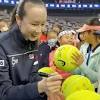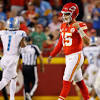Saskatoon Blind Hockey holds fundraiser


Carol BaldwinLocal Journalism Initiative ReporterWakaw Recorder
Hockey is not just for the sighted. It is for anyone with a love for the game. The players on the Saskatoon Blind Hockey Team redefine what it means to have heart and determination on the ice.
A fundraising steak supper was held on Sunday, February 9, at the Saskatoon Soccer Centre on Nelson Road. The funds raised will be used for ice time and equipment and to help with tournament fees for some of the players. Saskatoon Blind Hockey receives some funding each year through the Saskatchewan Blind Sport Association, but it is not enough to cover all the costs; therefore, some fundraising is necessary.
On Monday, January 13th, 2025, the Saskatchewan Blind Sports Association again hosted a Saskatoon Try Skating and Blind Hockey Event in partnership with Canadian Blind Hockey and the Saskatoon Blades. A ‘Try Skating and Blind Hockey’ event was held for the first time in Saskatoon after a nine-year absence in 2023, and it was there that Glen, one of the organizers of Saskatoon’s team, first became aware of blind hockey. Glen’s son is Adam Kugler-Sprayson, a member of the Blind Hockey community, who has participated at the national level since 2023 and was part of a Blind Hockey showcase in May 2024 in Calgary ahead of the World Para Ice Hockey Championship. When Canadian Blind Hockey came to Saskatoon and held the first “Try Blind Hockey” event, Glen knew, after checking it out, that he wanted to develop the program in Saskatoon. He explains that blind hockey is a safe place for visually impaired youth, whether partially sighted or completely blind, and adults to come out and try the sport. The players have a variety of types of visual impairment and a range of abilities, and the program allows them to play the game and build community at the same time.
Canadian Blind Hockey is a national registered charity that runs children’s ‘try-it’ sessions, learn-to-skate programs, development camps, and eastern and western regional tournaments for young people aged four to eighteen. Their flagship is the Canadian National Blind Hockey Tournament.
Blind Hockey is a parasport and is a variation of ice hockey designed for athletes who are blind or partially sighted. The sport features modified rules and equipment, most notably an adapted puck that makes noise and is about three times larger than a traditional puck. The jerseys are different as well. In regular hockey, one team will wear a dark jersey while the other team wears a white one. For visually impaired players, a white jersey can blend in with the boards around the rink, so in blind hockey, one team wears a dark jersey and the other a vibrant colour, usually yellow.
In recreational play, all athletes must be visually impaired, while at the competitive level, players must be classified as legally blind, defined as having approximately ten percent vision or less. Although there are no restrictions on where skaters can move on the ice, skaters with the most vision typically play as forwards and participate in all three zones. Those with less vision or no vision usually take on defensive roles. All goaltenders have extremely low vision or are completely blind and wear blindfolds while playing.
The puck is the single most important adaptation that makes ice hockey accessible to athletes who are blind or partially sighted. A traditional puck is solid, constructed of rubber, measures three inches across and one inch high, and makes no noise. A Blind Hockey puck is hollow, constructed of thin steel, measures five and a half inches across by one and two-thirds of an inch high, and contains ball bearings which rattle around and make a noise similar to rattling tin cans as it crosses the ice. The sound and the larger size allow blind and partially sighted players to track its location as it moves around the ice.
Some members of the Saskatoon Blind Hockey have links to the local readership area. Adam’s mother, Dawn Kugler, is originally from Wakaw and still has family here. As well, Isaiah Gauthier of Martensville, whose mother came from Domremy, also plays with Saskatoon Blind Hockey. Isaiah made the news last year as the first Saskatchewan student to qualify for the Braille Challenge Finals, an international competition.
Emma Crosson, whose grandparents live at Rosthern, also tried out the ‘Try Skating and Blind Hockey’ when the program returned to Saskatoon in 2023. Saskatoon Blind Hockey was the first team active in Saskatchewan, and currently has about ten visually impaired youth players participating, five of whom are girls. Emma continues to play Blind Hockey and participates in Irish dancing.
When asked how they manage to practice with so many differing skill levels on one sheet of ice, co-coach Derek Crosson explained that younger or newer skaters practice their skating and basic hockey skills at one end of the ice, while the more experienced and older skaters and the adults will play and run drills on the other. The range of disability amongst the players can be fairly vast, so the coaching becomes almost a one-on-one basis. Some players have only limited vision, so coaches can still use visual examples, while others require more ‘hands-on’ instruction as they have very little or no visual abilities and require sound via vocal guidance, beepers, or the tapping of sticks, to guide them. Saskatoon’s team has been very fortunate to have members of the Saskatoon Blades, Huskies men’s and women’s hockey teams, and Saskatoon’s women’s hockey team, the Saskatoon Comets, come out and volunteer and assist with coaching.
Canadian Blind Hockey is the national sports organization for the Para sport of Blind Hockey in Canada. The Canadian Blind Hockey community includes boys and girls as young as four years old who are taking their very first strides on skates, to the elite members of the Canadian National Blind Hockey Team who proudly wear the Maple Leaf in international competition. Canadian Blind Hockey’s programming spans the country from coast to coast while supporting Canadian hockey players who are blind or partially sighted of all ages, from playing on the pond to the podium. Luca DeMontis, the program director of Canadian Blind Hockey, said as of two years ago, there were 14 blind hockey programs across the country, the program in Saskatoon made 15. Last year, six more programs were started, including one in Regina, and as of January 26, Winnipeg Blind Hockey became the first program in Manitoba, bringing the total number of programs to 22.
Monday, February 17 to Friday, February 21, at Merlis Belsher Place, 2010 College Drive, Saskatoon. CNIB, in partnership with Canadian Blind Hockey, is launching a brand-new hockey camp in Saskatchewan for youth who are blind or who have sight loss or low vision. The hockey camp opportunity is being held over 5 days and will teach youth the fundamentals of how to play blind hockey while also developing skating skills. Saskatoon Blind Hockey have ice time weekly on Sundays from 3 – 4 p.m. at Merlis Belcher Arena.
Saskatchewan Blind Sports Association is a volunteer-based not-for-profit organization that facilitates Blind Sports in Saskatchewan. Sponsors include both Sask Lotteries and Sask Sport.



 Canada
Canada Argentina
Argentina  Australia
Australia  Austria
Austria  Brazil
Brazil  Chile
Chile  Czechia
Czechia  France
France  Germany
Germany  Greece
Greece  Italy
Italy  Mexico
Mexico  New Zealand
New Zealand  Nigeria
Nigeria  Norway
Norway  Poland
Poland  Portugal
Portugal  Sweden
Sweden  Switzerland
Switzerland  United Kingdom
United Kingdom  United States
United States 
























